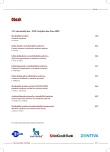-
Medical journals
- Career
Lipid-lowering treatment in metabolic syndrome
Authors: T. Štulc; R. Češka
Authors‘ workplace: Centrum preventivní kardiologie III. interní kliniky 1. lékařské fakulty UK a VFN Praha, přednosta prof. MUDr. Štěpán Svačina, DrSc., MBA
Published in: Vnitř Lék 2009; 55(7-8): 626-630
Category: 134th Internal Medicine Day - 23rd Vanysek's Day Brno 2009 - Vanysek's Lecture
Overview
During the last decades, metabolic syndrome has become an important healthcare problem worldwide. Main components of metabolic syndrome are insulin resistance (resulting often in impaired glucose tolerance and diabetes mellitus), dyslipidemia, hypertension and abdominal obesity. Incidence of metabolic syndrome is high and it substantially increases the risk of cardiovascular diseases. Dyslipidemia is a prominent factor contributing to the increased cardiovascular risk in metabolic syndrome, and lipid-lowerign therapy plays an important role in treating patients with this disorder. Most patients with dyslipidemia are treated with statins and/or fibrates. Statins are used for treatment of hypercholesterolemia; fibrates are indicated for treatment of hypertriglyceridemia and/or low HDL‑cholesterol. In high risk patients with severe mixed hyperlipidemia, combination of statins with fibrates may be necessary to achieve the lipid goals.
Key words:
metabolic syndrome – dyslipidemia – cardiovascular risk – lipid-lowering drugs – statins – fibrates
Sources
1. Reaven GM. Role of insulin resistance in human disease. Diabetes 1988; 37 : 1595–1607.
2. Ford ES, Abbasi F, Reaven GM et al. Prevalence of insulin resistance and the metabolic syndrome with alternative definitions of impaired fasting glucose. Atherosclerosis 2005; 181 : 143–148.
3. Lakka HM, Laaksonen DE, Lakka TA et al. The metabolic syndrome and total and cardiovascular disease mortality in middle-aged men. JAMA 2002; 288 : 2709–2716.
4. Isomaa B, Almren P, Tuomi T et al. Cardiovascular morbidity and mortality associated with the metabolic syndrome. Diabetes Care 2001; 24 : 683–689.
5. Brunzell JD, Hokanson JE. Dyslipidemia of central obesity and insulin resistance. Diabetes Care 1999; 22 (Suppl 3): C10–C13.
6. Manninen V, Tenkanen L, Koskinen P et al. Joint effects of serum triglyceride and LDL cholesterol and HDL cholesterol concentrations on coronary heart disease risk in the Helsinki Heart Study. Implications for treatment. Circulation 1992; 85 : 37–45.
7. Cífková R, Škodová Z. Dlouhodobétrendy hlavních rizikových faktorů kardiovaskulárních onemocnění v české populaci. Čas Lék Čes 2004; 143 : 219–226.
8. Vaverková H, Soška V, Rosolová H et al. Doporučení pro diagnostiku a léčbu dyslipidemií v dospělosti, vypracované výborem České společnosti pro aterosklerózu. Vnitř Lék 2007; 53 : 181–197.
9. Eilat-Adar S, Eldar M, Goldbourt U. Association of intentional changes in body weight with coronary heart disease event rates in overweight subjects who have an additional coronary risk factor. Am J Epidemiol 2005; 161 : 352–358.
10. Cholesterol Treatment Triallists’ (CTT) Collaborators. Efficacy and safety of cholesterol-lowering treatment: prospective meta‑analysis of data from 90 056 participants in 14 randomised trials of statins. Lancet 2005; 366 : 1267–1278.
11. Collins R, Armitage J, Parish S et al. MRC/BHF Heart Protection Study of cholesterol-lowering with simvastatin in 5963 people with diabetes: a randomised placebo-controlled trial. Lancet 2003; 361 : 2005–2016.
12. Colhoun HM, Betteridge DJ, Durrington PN et al. Primary prevention of cardiovascular disease with atorvastatin in type 2 diabetes in the Collaborative Atorvastatin Diabetes Study (CARDS): multicentre randomised placebo-controlled trial. Lancet 2004; 364 : 685–696.
13. Birjmohun RS, Hutten BA, Kastelein JJ et al. Efficacy and safety of high‑density lipoprotein cholesterol-increasing compounds: a meta‑analysis of randomized controlled trials. J Am Coll Cardiol 2005; 45 : 185–197.
14. Keech A, Simes RJ, Barter P et al. Effects of long‑term fenofibrate therapy on cardiovascular events in 9795 people with type 2 diabetes mellitus (the FIELD study): randomised controlled trial. Lancet 2005; 366 : 1849–1861.
15. Kamanna VS, Kashyap ML. Mechanism of action of niacin. Am J Cardiol 2008; 101 : 20B–26B.
16. Drazen JM, D’Agostino RB, Ware JH et al. Ezetimibe and cancer – an uncertain association. N Engl J Med 2008; 359 : 1398–1399.
17. Barter PJ, Caulfield M, Eriksson M et al. Effects of torcetrapib in patients at high risk for coronary events. N Engl J Med 2007; 357 : 2109–2122.
Labels
Diabetology Endocrinology Internal medicine
Article was published inInternal Medicine

2009 Issue 7-8-
All articles in this issue
- Treatment of hypertension in metabolic syndrome
- Treatment of diabetes in metabolic syndrome
- Metabolic syndrome and the liver (NAFLD/NASH)
- Anxious-depressive disorders and metabolic syndrome
- Metabolic syndrome and cardiovascular disease
- Chronic mild inflammation links obesity, metabolic syndrome, atherosclorosis and diabetes
- Laboratory markers of metabolic syndrome in clinical practice
- Treatment of dyslipidemia in patients with metabolic syndrome and chronic kidney disease
- Metabolic syndrome
- Obesity treatment in metabolic syndrome patients
- Lipid-lowering treatment in metabolic syndrome
- Internal Medicine
- Journal archive
- Current issue
- Online only
- About the journal
Most read in this issue- Metabolic syndrome and the liver (NAFLD/NASH)
- Anxious-depressive disorders and metabolic syndrome
- Chronic mild inflammation links obesity, metabolic syndrome, atherosclorosis and diabetes
- Laboratory markers of metabolic syndrome in clinical practice
Login#ADS_BOTTOM_SCRIPTS#Forgotten passwordEnter the email address that you registered with. We will send you instructions on how to set a new password.
- Career

